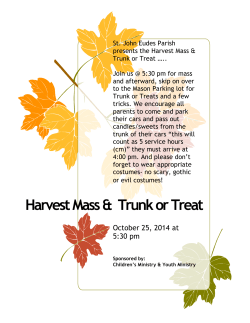
The Commercial Storage of Fruits, Vegetables, and
Netted Melons Krista C. Shellie and Gene Lester Kika de la Garza Subtropical Agricultural Research Center USDA, ARS, Weslaco, TX Scientific Name and Introduction: Cucumis melo L. (Reticulatus Group), commonly called cantaloupe or muskmelon, is a member of the Cucurbitaceae family (Bailey, 1976). True cantaloupe, the Cantaloupensis Group, are non-netted fruit common to Cantaluppi, Italy and are seldom grown in the U.S. Western shipper type melons (grown in Arizona, California, and Texas) are principally for domestic and export markets, while Eastern Choice type melons (grown in the eastern U.S.) are more perishable and are used principally for local consumption. A heavy, uniform, tan-colored net and bright orange flesh characterizes the external appearance of Western Shipper and Eastern Choice type melons. Eastern Choice melons are often deeply sutured, while Western shipper melons usually lack sutures. Charentais, Galia, Ananas, and Persian melons are not commonly grown in the U.S., but are gaining popularity as specialty melons. The French Charentais is a round, sparsely netted melon with a grey-green rind having pronounced dark-green longitudinal tracts, and a sweet, highly-scented, orange flesh. The Galia melon from Israel is characterized by a fine, uniform net, round shape, and green flesh (Karchi and Govers, 1977). Ananas type melons have a sparse, cracked net and white, very sweet flesh. The shape and netting of Persian melons are similar to Western Shipper type melons, but Persian melons are larger at about 6 lb (2.7 kg) each, and have a bright, orange-pink flesh. Quality Characteristics and Criteria: To meet U.S. grade standards, melons must have: sufficient maturity to insure completion of ripening; sufficient firmness (not soft or wilted); shape and netting characteristic for their type; a stem scar not wet and slippery (wet slip); no sun scald (solar injury); flesh and rind free of decay by fungi or bacteria; and absence of damage (USDA, 1981). Damage includes liquid in the seed cavity, hail injury, surface mold, aphid honeydew, scars, cracks, ground spot rind disorders, bruises, and mechanical damage. A minimum SSC of 11% and 9% is required for U.S. grades Fancy and U.S. No. 1, respectively. State market order quality standards may exceed federal grade requirements. Horticultural Maturity Indices: Stem separation and background rind color are used to indicate acceptable maturity for harvest. As netted melons begin to ripen, a separation layer, or abscission zone, develops at the point where the stem attaches to the fruit. Most netted melons are commercially harvested when ½ of the stem has separated from the melon (referred to as ½ slip) (Kasmire et al., 1970). Abscission zone development often corresponds to a change from green to yellow in rind background color. If picked at proper maturity, netted melons will continue to soften and become more aromatic after harvest (Shellie, 1995; Ayub et al., 1996). Netted melons harvested prematurely by cutting the stem prior to abscission zone development may produce little aroma, have low SSC, and not properly ripen (Lyons et al., 1962). Grades, Sizes and Packaging: U.S. Grades for cantaloupes (USDA, 1981) include: U.S. Fancy, U.S. No. 1, U.S. Commercial, and U.S. No. 2. The difference among Grades reflects levels of tolerance for quality criteria. A minimum SSC of 11% is required for U.S. Fancy and 9% for U.S. No 1. There are six common size classes (9, 12, 15, 18, 23 and 30) based on the number of fruit of uniform size and weight that fit into a standard, 40-lb (18 kg) cardboard shipping box. Pre-cooling Conditions: Pre-cooling to a fruit center temperature of 10 to 15 °C (50 to 59 °F) soon after harvest is recommended to delay ripening and retain sugar content. Hydro-cooling, forced-air cooling, and top-icing are acceptable, but hydro-cooling is most efficient (Kader, 1992). Optimum Storage Conditions: Optimum is 2 to 7 °C (36 to 45 °F) with 95% RH (Saltveit, 1997). The expected shelf-life at these recommended conditions is 10 to 14 d. Controlled Atmosphere (CA) Considerations: CA in transit and/or storage has some potential for extending shelf-life. The recommended level of O2 is 3 to 5% for reducing respiration and ethylene production. The recommended level of CO2 is 10 to 20% for reducing loss of sugar and surface molds. Storage in an atmosphere containing > 10% CO2 may result in a carbonated taste that is lost during subsequent storage in air. Off-flavors, odors, and impaired ripening may develop if netted melons are stored < 1% O2 or > 20% CO2 (Kader, 1992; Saltveit, 1997). Retail Outlet Display Considerations: The shelf-life of netted melons can be maximized by storage under refrigeration and by avoiding postharvest exposure to ethylene. Chilling Sensitivity: Sensitivity decreases as fruit mature. Full-slip, netted melons may be stored for 5 to 14 days at 0 to 2 °C (32 to 36 °F). Less mature melons may be damaged by storage < 2 °C (36 °F). Injury symptoms include pitting, surface decay, and failure to ripen (Wang, 1990). Ethylene Production and Sensitivity: Netted melons are climacteric fruit that produce 10 to 100 µL kg-1 h-1 ethylene (Kader, 1992) from 4 days prior to stem separation up to 10 days after harvest (Shellie and Saltveit, 1993; Shellie, 1995). Postharvest exposure to ethylene reduces shelf-life and should be avoided. Exogenous ethylene application after harvest will not ripen netted melons harvested prematurely, nor will it prevent normal postharvest decline in SSC. Respiration Rates: Netted melons have a moderate rate of respiration (Kader, 1992). Temperature mg CO2 kg-1 h-1 0 °C 5 to 6 4 to 5 °C 9 to 10 10 °C 14 to 16 15 to 16 °C 34 to 39 20 to 21 °C 45 to 65 25 to 27 °C 62 to 71 To get mL kg-1 h-1, divide the mg kg-1 h-1 rate by 2.0 at 0 °C (32 °F), 1.9 at 10 °C (50 °F), and 1.8 at 20 °C (68 °F). To calculate heat production, multiply mg kg-1 h-1 by 220 to get BTU per ton per day or by 61 to get kcal per metric ton per day. Data are from Sholz et al. (1963). Physiological Disorders: Solar injury causes patchy ground color or “bronzing” and net discoloration. Severely injured tissue becomes sunken or wrinkled (Snowden, 1992). Vein track browning, a darkening of the longitudinal tracts between netted areas, is caused by exposure to sun or high temperature at harvest (Snowden, 1992). Netted melons are easily injured and should never be dropped more then 60 cm (2 ft). Harvest and packing equipment should be padded to reduce scuffing of netting (Ryall and Lipton 1978). Avoidance of wounding during handling (compression, bruising, or scuffing) and storage under recommended conditions provides protection against physical injury and decay. Postharvest Pathology: Fusarium rot is the most common disease (Zitter et al., 1996). Symptoms vary depending on Fusarium species, but large fissures and an enlarged or thickened, dark-tan net at the lesion site is common. A distinct delineation is apparent between diseased and healthy tissue. There is often no sign of infection prior to harvest, but numerous spongy white lesions may develop internally postharvest. Fungicide application in a hot-water dip, 1 min at 57 °C (135 °F) can suppress Fusarium fruit rot. Other less common diseases include: black rot incited by (Didymella bryoniae or Phomopsis cucurbitae); Rhizopus soft rot (Rhizopus stolonifer); bacterial brown spot (Erwinia ananas); bacterial soft rot (Erwinia carotovora); and Alternaria (Alternaria alternata). Quarantine Issues: Melons entering the U.S. must be disinfested of external feeders (noctuid moths, thrips, and Copitarsia species) by fumigation with methyl bromide (APHIS, 1998). Methyl bromide was identified in 1987 as having an ozone depleting potential of 0.4 and is scheduled for global phase out under the Montreal Protocol. Title VII of the U.S. Clean Air Act requires phasing out production and importation of substances with ozone depleting potentials of 0.2 or greater by the year 2005. Use of methyl bromide for pre-shipment and quarantine is exempt from these restrictions, but limited supply and increased costs may make methyl bromide undesirable in the near future. Suitability as Fresh-cut Product: Harvest maturity, cultivar, growing location, cultural practices, and postharvest handling influence quality of the processed product. Netted melons destined for fresh-cut should be harvested at the earliest maturity acceptable for minimum sugar content and proper ripening, and be pre-cooled immediately after harvest. Firm cultivars should be selected that have a high sugar content, bright orange flesh color, and small cavity, ie., high piece yield. Melons should be rinsed in 200 µL L-1 of 5.25% NaOCl at 5 °C (41 °F) at pH 6.5 to 7.0 for 5 min. The whole melon is cut into cubed pieces with sharp blades. Pieces should then be rinsed with 150 µL L-1 of the above chloride solution at 5 °C (41 °F) for 30 sec prior to packaging. A shelf-file of 6 to 10 days can be expected for orange-fleshed melon cubes stored at 0 to 5 °C (32 to 41 °F). A modified atmosphere of 8 to 10% CO2 in air is beneficial for retarding microbial growth, as well as slowing softening and other quality changes. Special Considerations: Use of liners in cardboard shipping boxes may reduce fruit moisture loss and extend storage-life (Lester and Bruton, 1986). References: APHIS. 1998. T101-o-2 MB Methyl bromide fumigation of melons for external feeders. In: Plant Protection and Quarantine Treatment Manual. USDA, Hyattsville MD, pp. 5.2.23. Ayub, R., M. Guis, M. Ben Amor, L. Gillot, J. Roustan, A. Latche, M. Bouzayen, and J. Pech. 1996. Expression of ACC oxidase antisense gene inhibits ripening of cantaloupe melon fruits. Nat. Biotech. 14:862-866. Bailey, L.H. and E.Z. Bailey. 1976. Hortus Third. Macmillan Pub. Co. New York NY. Kader, A.A. 1992. Postharvest technology of horticultural crops. Univ. of Calif. Pub. No. 3311 Oakland CA, pp. 192. Karchi, Z. and A. Govers. 1977. Galia melon- a new F1 hybrid export and local market. Hassadeh 57:630-634. Kasmire, R.F., L. Rappaport, and D. May. 1970. Effects of 2-chloroethylphosphonic acid on ripening of cantaloupes. J. Amer. Soc. Hort. Sci. 95:134-137. Lester, G.E. and B.D. Bruton. 1986. Relationship of netted muskmelon fruit water loss to postharvest storage-life. J. Amer. Soc. Hot. Sci. 111:727-731. Lyons, J.M., W.B. McGlasson, and H.K Pratt. 1962. Ethylene production, respiration, and internal gas concentrations in cantaloupe fruits at various stages of maturity. Plant Physiol. 37:31-36. Ryall, A.L. and W.J. Lipton. 1979. Handling, transportation and storage of fruits and vegetables. Vol. 1, Vegetables and melons. AVI Pub. Co., Westport CT. Saltveit, M. 1997. A summary of CA and MA requirement and recommendations for harvested vegetables. In: M.E. Saltveit (ed) CA ’97 Proc., Vol. 4, Vegetables and Ornamentals. Univ. of Calif., Davis CA, pp. 98-117. Shellie, K.C. and M.E. Saltveit. 1993. The lack of a respiratory rise in Muskmelon fruit ripening on the plant challenges the definition of climacteric behaviour. J. Exp. Bot. 44:1403-1406. Shellie, K.C. 1995. Enhancing ripening characteristics of ‘Netted, Orange-flesh’ and ‘Smooth, Green-flesh’ type melons (Cucumis melo L.). In: G.E. Lester and J.R. Dunlap (eds) Proc. Cucurbitacae ’94 Evaluation and Enhancement of Cucurbit Germplasm. Gateway Printing Co., Edinburg TX, pp. 101-103. Sholz, W.W., H.B. Johnson, and W.R. Buford. 1963. Heat evolution rates of some Texas-grown fruits and vegetables. J. Rio Grande Valley Hort. Soc. 17:170-175. Snowden, A. 1992. Color atlas of postharvest diseases and disorders of fruits and vegetables. CRC Press, Boca Raton FL. USDA. 1981. United States Standards for Grades of Cantaloupes. USDA, Wash. DC, pp. 6. Wang, C.Y. 1990. Chilling injury of horticultural crops. CRC Press, Boca Raton FL, pp. 313. Zitter, T.A, D.L. Hopkins and C.E. Thomas. 1996. Compendium of cucurbit diseases. Amer. Phytopath. Soc., St. Paul MN.
© Copyright 2025










